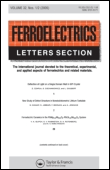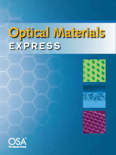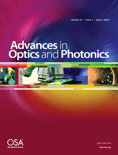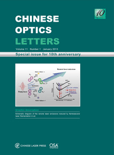
Photonics Letters of Poland
Scope & Guideline
Cultivating a Community of Photonics Innovators
Introduction
Aims and Scopes
- Optical Sensing and Measurement Techniques:
Research in this area includes the development and optimization of sensors utilizing optical techniques, such as fiber optic sensors and photonic crystal fibers, aimed at enhancing detection limits and measurement accuracy. - Photonics Materials and Devices:
This scope covers the investigation of new materials and devices for photonics applications, including phosphors, LEDs, and lasers, with a focus on improving performance characteristics and exploring novel functionalities. - Numerical and Theoretical Modeling:
The journal emphasizes the importance of numerical simulations and theoretical models in understanding photonic phenomena, including modeling of light propagation, sensor behavior, and material interactions. - Integrated Photonics and Optical Systems:
This area focuses on the design and fabrication of integrated photonic circuits and systems, exploring applications in telecommunications, sensing, and imaging. - Biophotonics and Medical Applications:
Research related to biophotonics, including the use of optical techniques for medical diagnostics, imaging, and treatment, is a significant focus of the journal.
Trending and Emerging
- Machine Learning and AI in Photonics:
There is a growing interest in the application of artificial intelligence and machine learning techniques to enhance the functionality and efficiency of photonic systems, particularly in sensor applications. - Advanced Materials for Photonics:
Research on novel materials, such as graphene and perovskites, is becoming increasingly prominent, reflecting a trend towards exploring materials that offer unique optical properties for innovative photonic applications. - Thermal Management in Photonic Devices:
An emerging theme is the optimization of thermal management strategies for photonic devices, particularly LEDs and lasers, to improve their efficiency and longevity. - Environmental and Biological Applications of Photonics:
Research focusing on the application of photonics in environmental monitoring and biological imaging is on the rise, highlighting the role of optical technologies in addressing global challenges. - Integration of Photonics with Other Technologies:
There is an increasing trend towards the integration of photonics with other technologies, such as telecommunications and renewable energy systems, emphasizing interdisciplinary approaches in research.
Declining or Waning
- Traditional Holography Techniques:
Research focusing on classic holography methods has decreased, possibly due to the rise of digital holography and advanced imaging techniques that offer greater flexibility and capabilities. - Basic Optical Properties of Materials:
There is a noticeable decline in studies solely focused on the fundamental optical properties of materials, as the field is increasingly leaning towards applications and practical implementations. - Low-Technology Photonic Devices:
Papers centered around simple, low-technology photonic devices have become less common as the emphasis shifts toward more complex and integrated photonic systems.
Similar Journals

FERROELECTRICS LETTERS SECTION
Connecting Scholars Through Ferroelectric DiscoveriesFERROELECTRICS LETTERS SECTION, published by Taylor & Francis Ltd, is a pivotal journal dedicated to the field of ferroelectric materials and their applications within condensed matter physics and electronic, optical, and magnetic materials. Established in 1983, this journal serves as an essential platform for researchers and professionals keen on advancing the understanding of ferroelectric phenomena and exploring their potential in contemporary technological applications. Despite its current positioning in the Q4 quartile categories and modest Scopus rankings, the journal plays a crucial role in disseminating research findings and fostering dialogue among scholars. With an emphasis on high-quality, peer-reviewed articles, FERROELECTRICS LETTERS SECTION encourages contributions that enhance the scientific community's comprehension of material sciences and associated emerging technologies. Although no Open Access options are currently listed, the journal offers a valuable repository of knowledge poised to attract students, researchers, and industry professionals alike, looking to stay abreast of the latest trends and discoveries in the field.

Liquid Crystals Today
Navigating the Dynamic World of Liquid CrystalsLiquid Crystals Today, published by Taylor & Francis Ltd, is an essential platform for researchers and professionals focusing on the fascinating field of liquid crystals. With an ISSN of 1358-314X and an E-ISSN of 1464-5181, this journal covers significant advancements in areas such as Condensed Matter Physics, Inorganic Chemistry, and Materials Chemistry, reflected in its recent classification within the Q3 quartile across these categories. Established in 1991 and with a rich history of disseminating impactful research, the journal provides critical insights and discussions pertinent to the scientific community. Although it does not follow an open-access model, its rigorous peer-review process ensures high-quality publications that contribute to the body of knowledge in liquid crystals. Researchers looking to stay updated in this dynamic field will find Liquid Crystals Today an invaluable resource.

Optical Materials Express
Exploring the cutting-edge of optical and magnetic materials.Optical Materials Express is a leading open-access journal dedicated to the rapid dissemination of research in the field of optical materials, published by the esteemed Optica Publishing Group. Since its inception in 2012, the journal has played a pivotal role in advancing knowledge and innovation in Electronic, Optical, and Magnetic Materials, currently maintaining a commendable Q2 classification in the 2023 category rankings. With a Scopus rank of 86 out of 284 in its category, the journal proudly boasts a 69th percentile positioning, underscoring its impact and relevance within the scientific community. The journal publishes high-quality, peer-reviewed articles that explore both fundamental and applied aspects of optical materials, making it an essential resource for researchers, professionals, and students alike. Located in Washington, DC, and accessible to a global audience, Optical Materials Express continues to foster collaboration and innovation among scholars in this vibrant field.

Advanced Photonics Research
Fostering Collaboration, Driving DiscoveryAdvanced Photonics Research is a leading open-access journal published by WILEY, dedicated to advancing the field of photonics through rigorous research and comprehensive reviews. With its ISSN 2699-9293, the journal aims to disseminate innovative findings in areas such as photonic materials, devices, systems, and applications. Since transitioning to an Open Access model in 2020, it has significantly increased accessibility for researchers, professionals, and students alike, promoting wider dissemination and collaboration within the global photonics community. The journal's commitment to high-quality, peer-reviewed content ensures it remains an essential resource for those seeking to stay at the forefront of photonics research. Positioned to influence both academia and industry, Advanced Photonics Research is an invaluable platform for sharing cutting-edge discoveries that drive the future of technology.

Journal of the European Optical Society-Rapid Publications
Accelerating Discoveries in Optics and PhotonicsJournal of the European Optical Society-Rapid Publications, with ISSN 1990-2573 and published by EDP Sciences S A, is a premier open access journal dedicated to advancing the field of optics and photonics since its inception in 2006. Based in France, this journal serves as a vibrant platform for researchers, professionals, and students to disseminate their findings quickly and efficiently. Achieving a commendable Q3 ranking in Atomic and Molecular Physics and Optics (2023), it reflects a growing impact within the scientific community, despite currently holding a 33rd percentile rank among similar publications in the realm of Physics and Astronomy. The journal fosters an environment of rapid communication and collaboration, making it an invaluable resource for those interested in the latest developments and innovations in optical sciences. With open access ensuring broad visibility for all published work, the Journal of the European Optical Society-Rapid Publications is positioned as a key contributor to enhancing the understanding and application of optical technologies.

Advances in Optics and Photonics
Driving Innovation in Atomic and Molecular PhysicsAdvances in Optics and Photonics, published by the Optica Publishing Group, stands at the forefront of research dissemination in the fields of Atomic and Molecular Physics and Optics, alongside its prominence in Water Science and Technology. With an impressive Q1 ranking in both categories and a Scopus rank of #2/224, this journal boasts a 99th percentile status, underscoring its significance in the academic community. As a beacon of knowledge since its inception in 2009, the journal is dedicated to featuring cutting-edge research, innovative methodologies, and transformative applications in optics and photonics that can drive advancements across diverse scientific domains. While not an open-access journal, it provides vital insights for researchers, professionals, and students eager to stay updated on emerging trends and breakthroughs. With a convergence period extending to 2024, Advances in Optics and Photonics is positioned as an essential resource for anyone looking to explore the evolving landscape of light-based technologies.

Chinese Optics Letters
Illuminating discoveries in optics and engineering.Chinese Optics Letters is a prestigious academic journal published by Chinese Laser Press, dedicated to advancing the fields of atomic and molecular physics, optics, as well as electrical and electronic engineering. Since its inception in 2003, this journal has become a significant platform for researchers and professionals to disseminate innovative findings and foster collaboration within these rapidly evolving disciplines. With a commendable Q2 ranking in leading categories including Atomic and Molecular Physics and Electronic, Optical and Magnetic Materials, it ranks favorably within the Scopus database, with notable positions in both engineering and materials science sectors. The journal is headquartered in Shanghai, China, and while additional open access options are not specified, it remains a vital resource for those committed to pushing the frontiers of optical research and applications. As we approach 2024, Chinese Optics Letters continues to play an essential role in shaping scholarly discourse and technological advancement in optics.

Acta Photonica Sinica
Exploring the Depths of Optical InnovationActa Photonica Sinica is a peer-reviewed academic journal published by SCIENCE PRESS, focusing on the fields of atomic and molecular physics and optics. Since its inception in 1997, this journal has provided a crucial platform for researchers and professionals to share cutting-edge findings and advancements in photonics and related areas. Despite its current positioning in the Q4 quartile for both atomic and molecular physics and optics, Acta Photonica Sinica remains a significant contributor to the scholarly community, fostering innovative discussions and collaborations. The journal does not currently offer open access, providing a selective but impactful repository of knowledge for readers in China and beyond. As the scientific landscape evolves, the journal aims to enhance its scope and impact, addressing the challenges and opportunities within the photonics domain. Researchers, students, and professionals interested in the latest theoretical and experimental studies will find a wealth of information that emphasizes the pivotal role of optics in scientific and technological advancements.

Journal of Nanophotonics
Catalyzing Collaboration in Nanophotonic ResearchThe Journal of Nanophotonics, published by SPIE-SOC Photo-Optical Instrumentation Engineers, is an esteemed platform dedicated to advancing the field of nanotechnology through pioneering research in photonics. Since its inception in 2007, this journal has become instrumental in disseminating innovative findings and fostering collaborative discussions, especially in the domains of Condensed Matter Physics, Electronic, Optical and Magnetic Materials, and Nanoscience and Nanotechnology. Currently ranked within the Q3 category across these fields, it serves as a vital resource for academics, industry professionals, and students keen on exploring the multifaceted applications and implications of nanophotonic technologies. With its convergence set to continue until 2024, the journal offers a non-open-access model, ensuring rigorous peer-review standards and high-quality publications that contribute to the global body of knowledge.

Opto-Electronic Advances
Exploring the Intersection of Light and TechnologyOpto-Electronic Advances is a premier open-access journal published by the Chinese Academy of Sciences' Institute of Optics & Electronics, dedicated to advancing the fields of optics and electronic engineering. Established in 2018, this journal quickly ascended to a Q1 ranking across multiple categories including Atomic and Molecular Physics, Electrical and Electronic Engineering, and Electronic, Optical and Magnetic Materials, showcasing its impact and relevance in the scientific community. With an impressive Scopus ranking placing it in the top percentiles for critical fields such as Engineering, Materials Science, and Physics, Opto-Electronic Advances provides a platform for researchers to publish their cutting-edge findings and foster dialogue in an increasingly interdisciplinary area of study. The journal emphasizes innovative research that contributes to practical applications and theoretical frameworks in its domain, making it an invaluable resource for academicians, industry practitioners, and students alike. Embrace the future of opto-electronic research with Opto-Electronic Advances, which has been fully open access since 2021, ensuring that knowledge is widely disseminated without barriers.